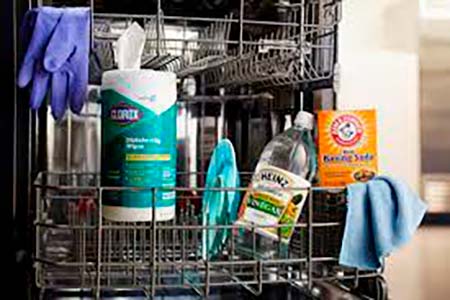In this article, you’ll learn how to reset a dishwasher, how to do it safely, avoid common mistakes, and what to do after resetting. We’ll also cover important maintenance tips to keep your dishwasher running smoothly.
Signs of a Clogged Drain

Before we delve into the cleaning process, let’s familiarize ourselves with the signs that your dishwasher drain might be clogged. Recognizing these signs early can help you address the issue promptly:
1. Slow Drainage: If you notice that your dishwasher is taking longer to drain than usual, it could be a sign of a clogged drain.
2. Water Puddles: Excess water remaining at the bottom of your dishwasher after a cycle is a clear indicator of a drainage problem.
3. Unpleasant Odors: A foul smell coming from your dishwasher indicates that food particles and debris are building up in the drain. Safety precautions
Safety Precautions
Before beginning the cleaning process, it is important to prioritize safety: into the cleaning process, it’s crucial to prioritize safety:
1. Turn Off the Power: To ensure your safety, unplug the dishwasher from the power source.
2. Water Supply: Turn off the water supply to the dishwasher to prevent leakage during cleaning. the water supply to the dishwasher to prevent any leaks during cleaning.
Tools and Materials

To effectively clean your dishwasher, drain, gather the following tools and materials:
1. Bucket: For catching any excess water that may spill during cleaning.
2. Screwdriver: To help with removing components if necessary.
3. Cleaning Brush: A small brush with stiff bristles for cleaning hard-to-reach areas.
Step-by-Step Guide to Clean Dishwasher Drains
Now, let’s get into the specifics of how to clean your dishwasher drain thoroughly:
Step 1: Empty the Dishwasher
Start by clearing the dishwasher of all dishes, cutlery, and baskets. This step ensures easy access to the drain area.
Step 2: Remove the Lower Rack
emove the lower rack of the dishwasher to access the drain components underneath.
Step 3: Locate the Drain
Locate the dishwasher drain, which is usually located at the bottom center of the appliance. Deposits tend to accumulate here.
Step 4: Remove Debris
Use your hands or a small brush to remove any visible debris or food particles from the drain area. Be thorough with this step as it is important to clear any blockages.
Step 5: Clean the Filter
Dishwashers are equipped with filters to catch dirt and prevent it from going down the drain. Take out the filter and clean it thoroughly to ensure it is working properly.
Step 6: Check the Drain Hose
Check the drain hose for any obstructions or kinks that could restrict water flow. If you find any, remove them to ensure proper drainage.
Step 7: Reassemble and Test
After cleaning the drain and filter, reassemble the lower rack and any components you removed. Once everything is back in place, run a short dishwasher cycle to ensure there are no leaks and that the drainage is working correctly.
Preventive Measures
To keep your dishwasher drain clean and prevent future clogs, consider the following preventive measures:
1. Scrape Dishes: Before loading dishes, scrape off excess food to reduce the likelihood of debris entering the drain.
2. Rinse Aid: Use rinse aid to help dishes dry more efficiently and prevent mineral buildup in the dishwasher.
3. Regular Maintenance: Make dishwasher drain cleaning a part of your regular maintenance routine to prevent issues down the road.
By following these steps and preventive measures, you can ensure that your dishwasher’s drain remains clog-free, allowing it to function at its best and prolonging its lifespan. Enjoy clean and hassle-free dishwashing!